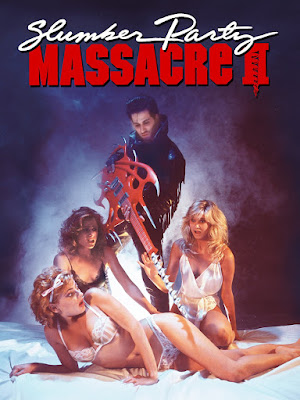Traumatised from the events of the previous movie, Courtney (Crystal Lynn Bernard) tries to move on by focusing on practising with her band (Kimberly McArthur, Juliette Cummins, and Heidi Kozak).
The group have decided to go away for a weekend and work on the music. Plus the boy she likes (Patrick Lowe) is going to join them.
Everything is perfect, except for the man of her dreams - a killer musician (Atanas Ilitch) who cannot wait to take Courtney out...
I reviewed this movie’s predecessor a few years ago. It has always been a favourite of mine. I was aware that there were sequels but I had no real interest in watching them (the poster does not help). Recently I have seen Slumber Party Massacre II pop up on lists of underrated horror flicks, and so I sought it out.
While it is technically a sequel to The Slumber Party Massacre, Slumber Party Massacre II works as its own entity. While the original charmed with its handmade quality, this sequel feels more polished. The photography is good and there are some striking images - the killer perched atop the house, shredding on his guitar while his victims scramble away in the foreground.
While written as a satire of the genre, The Slumber Party Massacre feels conservative next to its sequel.
While it does feature a killer, a group of victims and some gore-y kills, Slumber Party Massacre II remixes the ingredients into a surreal nightmare of pastels, plastic rockabilly and sexual repression.
While most of the story takes place in a single house, the main location - an eerily quiet suburban development - is the first sign that this movie takes place in a completely different world. The neighbourhood is so uniform and bland in appearance, it feels like it might be down the road from Edward Scissorhands’ hometown.
The main character, Courtney, was a minor character from the original, but she is played by a different actress. The key carryover is the emotional scars she carries from the original movie. The film’s supernatural antagonist is a melding of her past trauma, her passion for music and her burgeoning sexuality (and her fear of said sexuality).
Even though we get flashes of footage from the original, this connection is tenuous - you do not need knowledge of the original in order for this movie to work.
The movie is fairly simple - a group of friends go to an isolated location and are swiftly eliminated - but that simplicity gives the filmmakers the space to twist and bend the rules of the story world’s reality.
Most of the story’s tension comes from Courtney’s hallucinations of the Driller Killer (Atanas Ilitch).
The back half of the movie is fairly traditional slash-and-stalk, but it is made far more interesting (and surreal) by the Killer’s musical antics. While all the acting in the film is solid, Ilitch is fantastic as the villain. Smirking, cackling and sashaying through the movie, he is a force of nature.
One of the more interesting aspects of the movie is that it is based around a rock band. Courtney and her friends are more interested in becoming musicians than their boyfriends. This is a really interesting element in the movie, and I kind of wished there was a little more of it in the movie. One of the strongest aspects of the original movie was the relationship dynamics among the main characters - boys were only a minor element. Here, the dynamics feel more like a generic slasher movie, with the characters all pairing off.
Based on his garb, you could be forgiven for thinking the Driller Killer’s music would be cock rock or glam. Maybe this would have been the case if the movie had a bigger budget. Instead, the music plays into the film’s focus on recasting generic teen romance tropes.
I am no expert but the Killer’s music feels like it is meant to be a take-off on rockabilly - the lyrics are generic and repetitive in a manner that is designed to make the viewer feel as trapped as the characters.
There is a talking point about the 80s remaking the 50s, and this movie seems to be channeling that idea. The neighbourhood is a facsimile of the 50s, the music is a facsimile of the 50s and the Driller Killer’s persona is a facsimile of 50s dating rituals (cinematic at least).
I feel like there is a goldmine of analysis to be done on this film. Suffice to say that Slumber Party Massacre II is a really fun, unique slasher movie, and has more to offer than you may assume based on the title.
If you are new to this blog, I also co-host a podcast on James Bond, The James Bond Cocktail Hour.
You can subscribe on iTunes, or wherever you get your podcasts.





